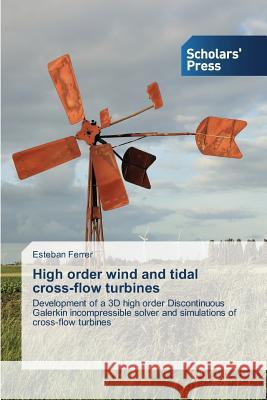High order wind and tidal cross-flow turbines » książka
High order wind and tidal cross-flow turbines
ISBN-13: 9783639707991 / Angielski / Miękka / 2014 / 260 str.
This work details the development and validation of an unsteady unstructured high order ( 3) h/p Discontinuous Galerkin (DG) - Fourier solver for the incompressible Navier-Stokes equations on static and rotating sliding meshes in 3D. This general purpose solver is used to provide insight into cross-flow (wind or tidal) turbine physical phenomena. To account for the relative mesh motion, the system of equations is written in arbitrary Lagrangian-Eulerian form and a non-conformal DG formulation is used for spatial discretisation. The DG method, together with a novel sliding mesh technique, allows direct linking of rotating and static meshes through the numerical fluxes. This technique shows spectral accuracy and no degradation of temporal convergence rates if rotational motion is applied to a region of the mesh. To simulate 3D flows, the solver is parallelised and extended using Fourier series, which enables DNS and turbulent LES simulations. Two LES methodologies are proposed. The thesis includes solutions for: Stokes flows, the Taylor vortex problem, flows around square and circular cylinders, flows around static and rotating NACA foils and rotating cross-flow turbines flows."
This work details the development and validation of an unsteady unstructured high order (≥3) h/p Discontinuous Galerkin (DG) - Fourier solver for the incompressible Navier-Stokes equations on static and rotating sliding meshes in 3D. This general purpose solver is used to provide insight into cross-flow (wind or tidal) turbine physical phenomena. To account for the relative mesh motion, the system of equations is written in arbitrary Lagrangian-Eulerian form and a non-conformal DG formulation is used for spatial discretisation. The DG method, together with a novel sliding mesh technique, allows direct linking of rotating and static meshes through the numerical fluxes. This technique shows spectral accuracy and no degradation of temporal convergence rates if rotational motion is applied to a region of the mesh. To simulate 3D flows, the solver is parallelised and extended using Fourier series, which enables DNS and turbulent LES simulations. Two LES methodologies are proposed. The thesis includes solutions for: Stokes flows, the Taylor vortex problem, flows around square and circular cylinders, flows around static and rotating NACA foils and rotating cross-flow turbines flows.











